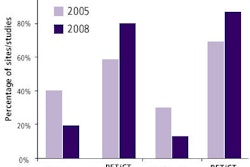With global supplies of molybdenum-99 (Mo-99) particularly strained over the past two years, several initiatives are under way in the U.S. to bring production of the medical isotope closer to home.
Among the developers is the University of Missouri Research Reactor (MURR) program, which has set in motion plans to build a target processing facility for Mo-99 adjacent to its current multipurpose research reactor on the school's main campus in Columbia.
According to a recent report from the U.S. National Academy of Sciences (NAS) on the global medical isotope market and the feasibility of converting to low-enriched uranium Mo-99 production, the U.S. demand for Mo-99 is approximately 6,000 six-day curies per week. Based on that estimate, MURR is preparing to make approximately 3,000 six-day curies per week.
"Our objective is to produce enough [Mo-99] to meet half the U.S. needs," said MURR director Ralph Butler. "Technically, we think we can do more than that. From the business perspective, I think 50% is the appropriate amount."
Cost estimates
The estimated cost to construct the new facility is between $30 million and $40 million, depending on final design. MURR plans to use low-enriched uranium to produce Mo-99 at the new facility, rather than the weapons-grade high-enriched uranium that's currently used for Mo-99 production.
The radiation of low-enriched uranium targets and the processing of those targets "requires a pretty hefty facility," Butler said. "We currently don't have those facilities available" in the U.S.
Butler expects the project to take approximately four years to design, construct, and license the facility, once funding is secured. MURR recently received a grant from the Missouri Life Sciences Research Trust Fund to fund the facility's design. "We have the first $1.1 million and we are out looking for other sources," Butler said. "I think in the next six months we will have that funding."
Project funding
MURR is exploring funding options that include both private dollars and possible public funding from the state of Missouri. "We have several donors and several companies that also have an interest," Butler added. "We are engaged in confidential conversations with several different organizations."
Federal government help for the project is less likely, Butler said, because the U.S. Department of Energy, for example, would need Congressional approval to appropriate funding for such a commercial venture.
The NAS report noted that MURR "appears to have most of the facilities and capabilities (except hot cells) needed to produce Mo-99 for the U.S. market. The organization is producing other medical isotopes for commercial companies. It also has experience with medical isotope regulation and good manufacturing practices. The MURR reactor also appears to have sufficient capability for target irradiation."
But the NAS report also cautioned that the primary regulatory barrier to producing Mo-99 at MURR is the "disposition pathway for the waste from target processing.... The classification of this waste as [high-level waste] or [low-level waste] will determine the cost and availability of disposal."
Global supply
In recent years, the worldwide supply of Mo-99 often has not met demand, due to scheduled and unexpected temporary shutdowns of nuclear reactors. Both the National Research Universal Reactor in Chalk River, Ontario, operated by Atomic Energy of Canada, and the High Flux Reactor in Petten, the Netherlands, operated by the Nuclear Research and Consultancy Group, have spent time offline in the past two years.
Currently, the National Institute of Radioelements' nuclear reactor in Fleurus, Belgium, is offline for repairs. The restart of that facility, initially expected this month (February), is on hold.
And, without domestic medical isotope production, nuclear medicine practitioners and radiopharmaceutical companies in the U.S. must import their entire supply.
"I think people have learned a lesson about relying on one or two facilities," Butler said. "It is better to have multiple facilities."
Last month, radiopharmaceutical firm Covidien of Hamilton, Bermuda, announced a partnership with Babcock & Wilcox (B&W) Technical Services Group of Lynchburg, VA, to further develop a new type of reactor technology that is simpler, cheaper, and more environmentally friendly than traditional reactors used for isotope production.
If successful, Covidien and B&W believe the technology also could supply more than 50% of U.S. demand for Mo-99 and potentially could produce other radioisotopes.
By Wayne Forrest
AuntMinnie.com staff writer
February 17, 2009
Related Reading
Covidien, B&W to tackle medical isotope dilemma, January 28, 2009
SNM criticizes NAS isotope report, January 16, 2009
Report: Use of low-enriched uranium in medical isotopes is feasible, January 15, 2009
NRCG reactor will be down longer, December 22, 2008
Belgium to restart medical isotope production, November 5, 2008
Copyright © 2009 AuntMinnie.com




















